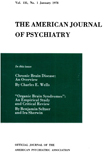Abstract
A study of AWOL cases routinely referred to the psychiatric clinic attached to the headquarters staff of Fort Eustis leads to the following conclusions:
1 . There was no difference in the rate of AWOLism between colored and white troops.
2. The intelligence level of the AWOL group as determined by the Army General Classification Test is very much lower than that of Fort Eustis as a whole.
3. There is a somewhat greater tendency for married men to go AWOL.
4. Most men who go AWOL are psychiatrically abnormal—only one-third were found to have no psychiatric condition.
5. One-third of the men who went AWOL were diagnosed as psychopaths.
6. In the AWOL group there is a high incidence of broken homes.
7. Alcoholism, criminalism and mental disorder mark the family background of these men.
8. A high percentage give a history of serious head injury, bed wetting and venereal infections.
9. A high percentage of men who go AWOL in the Army give a history of AWOLism while at school (marked truancy) and AWOLism at work (frequent quitting of jobs).
10. The great majority failed to complete grammar school and most of them had difficulty in passing.
11 . Over half of the men who go AWOL in the Army have been previously convicted by civilian courts.
12. Over 40 percent of these men discipline themselves poorly as evidenced by an excessive use of alcohol and tobacco.
13. One-third are heavy gamblers.
14. A third practice adult autoerotism and all but a small percentage were excessively autoerotic in childhood.
15. Nearly one-half began heterosexual relations before the age of 16 and the same number failed to use prophylactic devices at any time.
16. More than one-third showed marked finger tremors, markedly enlarged pupils and evidence of chronic fingernail biting.
17. The men who go AWOL are far less dependent upon friends both in their home and military communities than are well adjusted soldiers.
18. Over two-thirds had never engaged in any organized group activity in civilian life and half participated in no type of spare time athletic events in camp.
19. Eighty percent of the men left camp at every legitimate oportunity afforded them.
20. On the average, the AWOLer's home was further from camp than that of the men who did not go AWOL.
21. Men who went AWOL scored much lower in tests of general information on the war and in tests of military knowledge than a group of soldiers of similar intelligence level who had not gone AWOL.
22. Men who go AWOL, almost without exception, are greatly dissatisfied with all phases of army life.
23. They have little liking for their fellow soldiers and feel themselves poorly regarded by them.
24. Three-fourths of the men who go AWOL (and a fairly large percentage of soldiers in general) do not know why the Army should consider going AWOL a serious breach of discipline.
25. Truck drivers have a special tendency to go AWOL.
26. There is no special period in a 17-week training cycle in which men elect to go AWOL.

